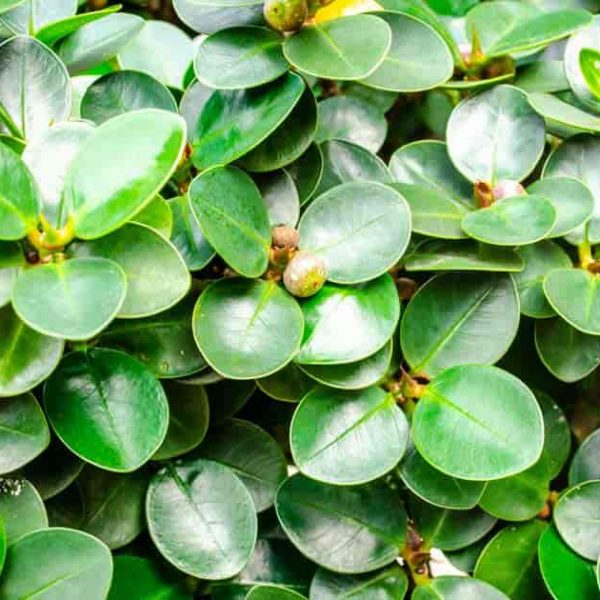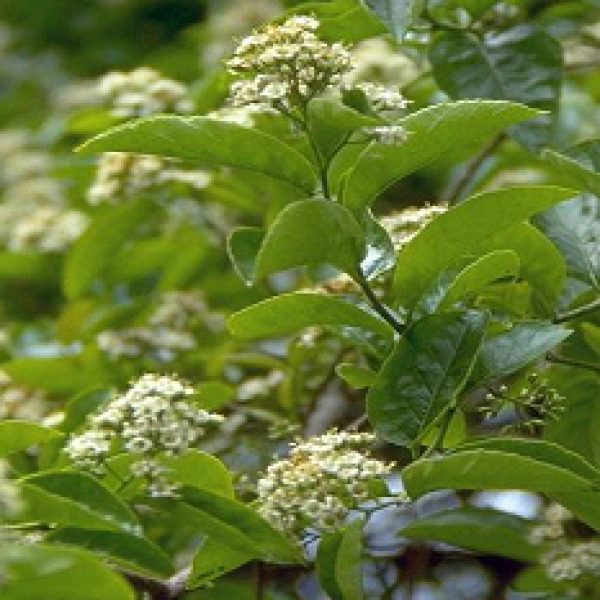
Buddhist monks at the Bodhi tree, Bodh Gaya
Tree / Plant worship has its roots in ancient times and continues to be an element of modern Indian traditions. Tree cults, in which a single or groves of trees have been worshipped, have flourished in India throughout history. In the scriptures, mention of the Kalpavriksha and Chaityavriksha is found, indicating that the worship of the plants is indeed an ancient Indian practice.
Plants have been traditionally considered sacred for the following reasons:
- Its close association with a deity. For example – Bilva tree (Aegle marmelos) with Lord Shiva, Neem tree (Azadirachta indica) with Mariamman and Tulsi (Ocimum sanctum)with Lord Krishna.
- Trees sheltering any object of worship like a deity, a fetish or a weapon have traditionally been considered sacred. Sthalavrikshas are actually the trees that first sheltered an open-air shrine, which was later replaced by a temple or shelter for the deity. The sacred tree became secondary and was worshipped along with other nature gods as the Sthalavrikshas of the temple and became an inseparable part of the faith.
- Some plants are believed to have originated from bodies or limbs of Gods and hence, the sanctity. For example, the Flame of the forest (Butea monosperma) is believed to have originated from the body of Lord Brahmaandthe Rudraksha tree(Elaeocarpus ganitrus) rose from the tears of Lord Shiva.
- Some plants become sacred through what might have occurred in their proximity. For example, the Peepal tree (Ficus religiosa), under which Gautama Buddha attained enlightenment, is considered sacred by the Buddhists.
- Plants that have an important socialoreconomic significance or a major role in the local ecology are also considered sacred. For example, the veneration of the Khejri tree (Prosopis spicigera)by the Bishnois of Rajasthan is related to the crucial role the tree plays in the desert ecology. It provides the community with food, fodder and building material.
LIST OF SACRED PLANTS
Bibliography
“Trees, Flowers and Fruits in Indian Folk Songs, Folk Proverbs and Folk Tales”, Glimpses of Indian Ethnobotany, pp 3-12, Oxford & IBH Publishing House, New Delhi.
The real and indigenous culture of any nation is reflected in its folklore plants have been an integral part of Indian life and culture, and hence it is but natural that all aspects of folk literature, namely folk songs, folk tales and folk proverbs of our country should have profuse references to trees, shrubs, climbers and their flowers and fruits.
“Ancient Indian Folk Cults”, Prithivi Prakashan, Varanasi, India, 1970.
There are very few books on the folk cults of India. The book on “Ancient Indian Folk Cults” is one of the most important works of reference on Indian Folk Cult. The book contains a wealth of information on festivals connected with the Bow, Mountain and Mountain Cave, Indra, River Goddess, Skanda, Rudra, Naga deity, Ocean and the Stupa and Chaitya. It also covers the worship of trees, Mukunda, Goddess Sri and the cult of Yakshas. It is an excellent summary of the study on ancient literature.
“Neem in Sociocultural Life in South Asia”, The Neem Tree, pp 579-584, VCH, Weinhem, Germany, 1995.
People all over India worship neem tree. The Hindu goddess Arulmigu Mariamman is synonymous with the neem tree and is worshipped for her curative powers. In many communities neem leaves are hung in bunches at the entrance to the house as a symbolic way to keep out infestations and evil spirit.
“Tulsi – A Sacred Plant”, Kisan World, Vol. 25, No.1, p.45, 1998.
Tulsi or the sacred basil is regarded as the most sacred herb in India with a hoary past. It is believed the Goddess Shri has been incorporated in it. The sacred herb not only has religious significance, but it also has important medicinal and environmental uses.
“Sacred Trees of Tamilnadu”, Eco News, Vol. 4, No.4, pp.12–16, C.P.R. Environmental Education Centre, Chennai, 1998.
Sthala vrikshas or sacred trees are found all over in India. In Tamilnadu, almost every temple is associated with a plant or tree connected and the history and mythology of the temple and deity. The tradition of associating trees with gods and goddesses traced from the sangam literatures.
“Sacred Trees of Tamilnadu”, C.P.R. Environmental Education Centre, Chennai, 1998.
The sacred trees or sthalavrikshas along with the sacred groves and sacred tanks are the three most important ecological traditions of Tamilnadu and have played a significant role in the protecting and preserving the environment. Each sacred tree is associated with a deity and a temple. Sacred trees are revered and worshipped by the devotees with specific taboos and customs. The 60 sthalavrikshas surveyed and recorded in this book were all found to have medicinal and mythological stories. The habitat and temples associated with the tree have also been discussed for each tree with accompanying sketches and photographs.
“Sthalavrikshas of Tamilnadu”, The Ecological Traditions of Tamilnadu, pp.83–93, C.P.R.Environmental Education Centre, Chennai, 1997.
Sthala vrikshas or sacred trees are found all over India. In Tamilnadu, almost every temple is associated with a plant or tree. This is sthala vriksha. The tradition of associating trees with gods and goddesses in Tamilagam can be traced back to ‘Sangam’ literature, which is full of references to more than hundred plants. In Tamilnadu 265 temples were visited and 60 ‘Sthalavrikshas’ were recorded.
“The blinding tree of India”, Blackbuck, Vol. 15, No.3, pp.63–66, 1999.
Thillai, the blinding tree of India, is found in the coastal forests. It has many medicinal properties. It is also used for making toys, furniture and also for fuel. This is the sthala vriksha or the sacred tree of the Lord Nataraja temple in Chidambaram.
“Neem Tree - A Review”, Indian Forester, Vol. 127, No.12, pp. 1336-1342, 2001.
The neem found use in the Indus Valley Civilization. References in Sanskrit literatures indicate its antiquity. It is sacred to the Hindus and is associated with the goddess Sitala, the small pox goddess. Apart from religious importance, it has various medicinal properties.gn
“Temples of Nature”, Discover India, Vol.12, No.3, pp.20-22, 1999.
Tree worship is a very ancient practice in India. It is believed that some trees are the abodes of Gods and spirits. Some of the most commonly worshipped trees are Banyan, Peepal, Wood-apple and Neem.
“On the Cult of the Plantain Tree and its Ethnographical Significance in Bengal”, Quarterly Journal of the Mythic Society, Vol. XLI, No. 1, pp. 1 – 7, The Mythic Society, Bangalore, 1950.
Among the existing tree-cults of Bengal the cult of the plantain tree has some special features.
“The Arts of India”, Rupa & Co., Calcutta, 1992.
The book “The Arts of India” is the most authoritative and important reference works on Indian Art. The book contains a wealth of information and is amply illustrated. A glance through the contents pages will show the wide scope of the work and the thoroughness, which went into its preparation. Many of the subjects described were at one time plentiful. As a source of reference it is indispensable and provides in a single volume more information than general works on India. The first part of the book discusses the sacred animals, plants and trees, places, mountains and rivers.
“The Great Banyan Tree”, Bulletin Of Botanical Survey of India, Vol. 29, No.1-4, pp 59-70, Botanical Survey of India, Calcutta, 1987.
The Great Banyan Tree in the Indian Botanic Garden, Howrah is a source of attraction to all visitors. In this paper its history, importace, growth, mythology, protection and training of prop roots have been discussed.
“Ethnobotanical Folk Practices and Beliefs of the Ao-Nagas in Nagaland, India”, Ethnobotany, Vol.8, pp 26-30, Deep Publications, New Delhi, 1996.
The aboriginal Naga tribes of Nagaland follow rich ethnobotanical, cultural and folk practices. Nagas have been utilizing plants growing in their surroundings not only as sources of food and herbal medicines, but also for their traditional religious ceremonies and beliefs.
“Vishnu’s Consort on Earth”, The India Magazine, Vol.12, 1992.
The veneration of trees and plants has been a common phenomenon all over the world. It is believed that they are the symbols of god or sprit. In India, many plants have been worshipped. The tulsi used to grow in almost all the Hindu houses. It is believed that Tulsi as the wife of Vishnu, a person of unparalleled virtue.
“In the Shade of the Bodhi Tree”, Art in America, pp. 172-180, (220-221), 1990.
The influential art of India’s Pala period is highly self-conscious and extravagantly ornate. It reveals parallels between this sophisticated Buddhists art, produced between the 7th and the 12th centuries, and the work of our own times.
“Tree and Serpent Worship”, Folklore of India, pp 237-259, New Delhi, 1993.
Worship of many trees plays an important role in popular rituals and folklore. It is believed that the tree is an embodiment of the gods and spirits. Folklore says the tree Kalpataru or Kalpadruma, the tree of Swarga or Indra’s paradise, granted all desires. Many tribes of India worshipped the tree as their totemic symbol.
“Trees and shrubs in Religion and Mythology”, Tree World, Vol. 3, No. 6., pp. 3-4, 1995.
From time immemorial tree worship has occupied an important place in the religious sentiments of Indian People. Many trees have profoundly influenced the culture and civilization of man. Many folklore, myth and tales are also associated with trees.
“Sacred Plants”, The Folklore of Plants, pp. 243-261, Chatto and Windus, London, 1889.
Closely allied with plant-worship is the sacred and superstitious reverence, which from time immemorial, has been paid by various communities to certain trees and plants.
“Finding Shiva: Times in Bodhgaya”
Bodhgaya is the sacred city of Buddhist. Since, Buddha is said to have had his enlightenment. The Bodhi tree grows in the courtyard of the Mahabodhi Temple and said to be a descendent of the original Bo tree. Bodhgaya has become a virtual world’s fair of Buddha celebration.




















































